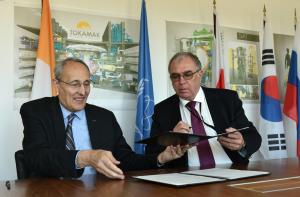Even closer cooperation
Under Practical Arrangements signed in June, the International Atomic Energy Agency and the ITER Organization will be expanding and deepening a long history of cooperation.
Since its inception in 1957, the International Atomic Energy Agency (IAEA) has worked to foster international collaboration in fusion research and development by facilitating the exchange of scientific and technical information among its Member States.
- As early as 1958, the newly created IAEA was entrusted with the responsibility of leading the global collaborative effort on fusion at the Second United Nations Conference on the Peaceful Uses of Atomic Energy, in Geneva.
- Supported by the dedicated community of fusion researchers in the Member States, the Nuclear Fusion journal was set up in 1960 by the IAEA to disseminate knowledge in this niche area of science. Today the journal is considered the main source of information about advances in nuclear fusion.
- An International Fusion Research Council was also established in 1971 to advise and provide guidelines to the IAEA Secretariat on matters relating to the fusion R&D program.
- The Agency played the role of godparent to the ITER Project through its early conceptual and engineering design phases, and kept the fusion community abreast of developments through ten years of ITER newsletters (1988-1998). The early cooperation phases and the ITER negotiation phases were carried out under the auspices of the IAEA.
- The Director-General of the IAEA is the Depositary of the ITER Agreement. A representative of the IAEA is invited to attend every ITER Council meeting.
- The IAEA hosts a variety of fusion-related forums, including the biennial Fusion Energy Conference, a series of workshops on the next phase DEMO, and many technical meetings.
- A Cooperation Agreement signed in 2008 with the ITER Organization formalized cooperation between the two institutions on the exchange of research results, training, publications, conferences, research, modelling, and safety and security.
- For the more than 120 IAEA Member States that are not part of the ITER Organization, the IAEA performs an important bridging function, disseminating knowledge from ITER to the wider community and providing a platform for exchange between ITER and the rest of the world.


